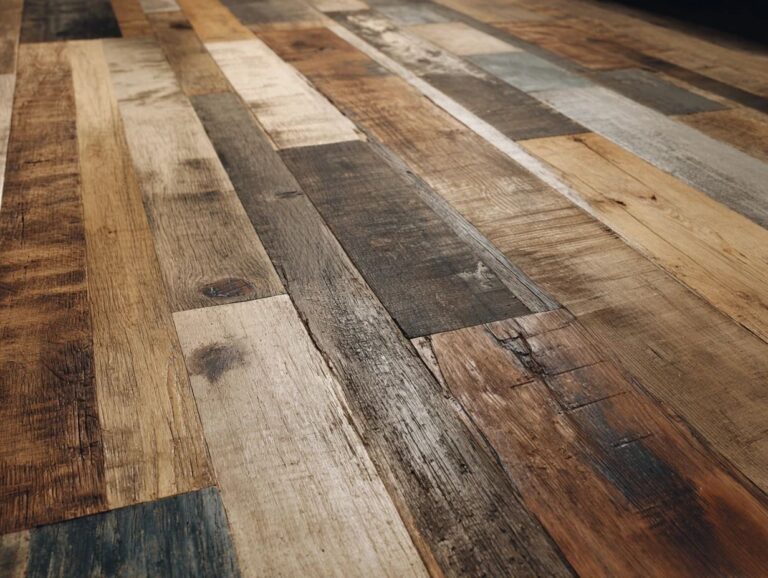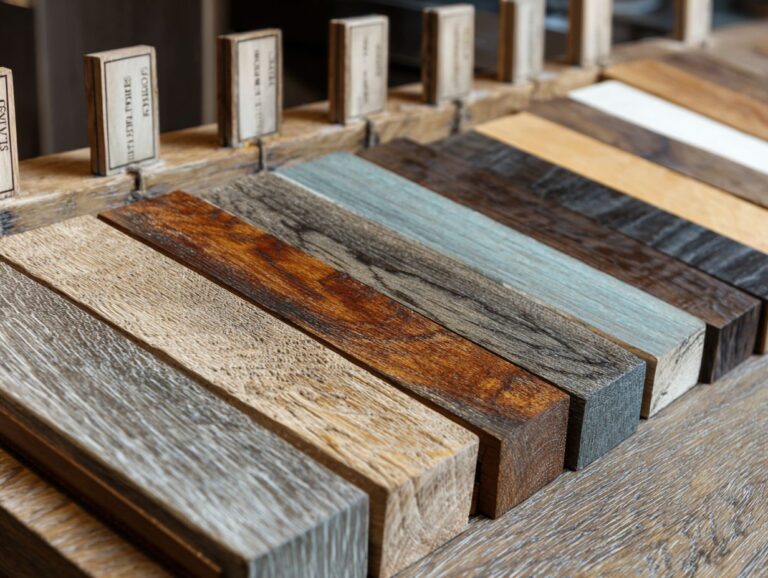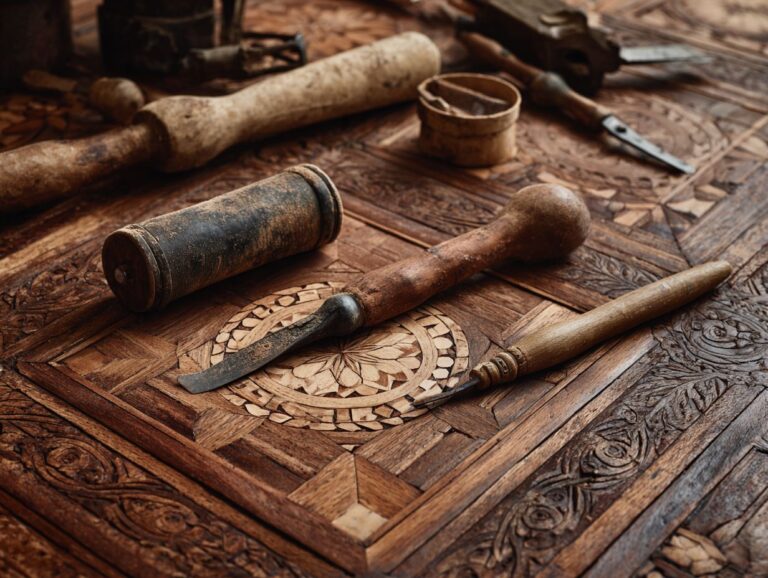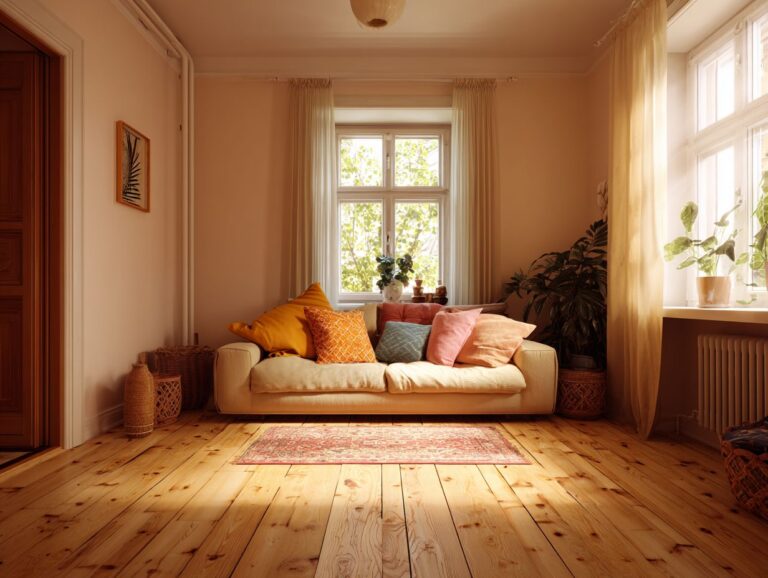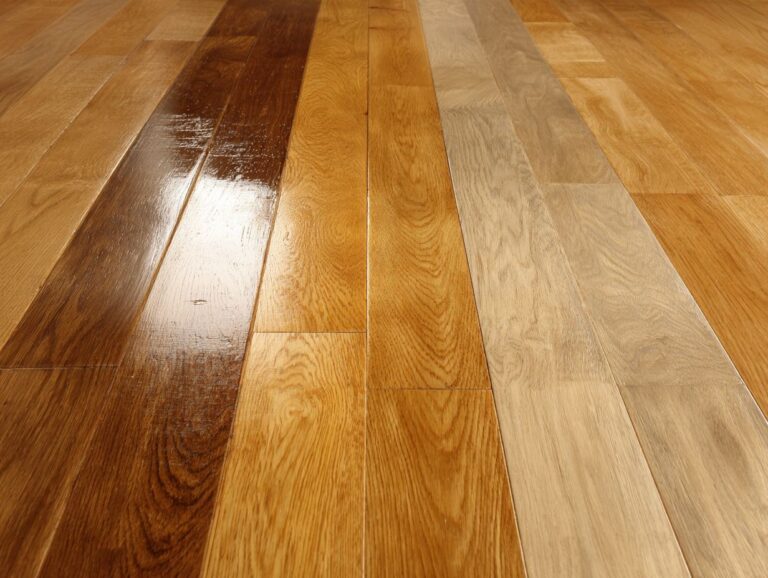Cork Flooring Benefits – Sustainability and Comfort Guide
Experience the unique blend of sustainability and comfort with cork flooring, an eco-friendly flooring option derived from the bark of cork oak trees. Renowned for its natural insulation properties, cork flooring offers a cozy atmosphere while being a sustainable resource for your home. In this guide, we will look into the many benefits of cork flooring, focusing on its eco-friendly features and the unique comfort it offers to your home. Check out this environmentally friendly choice for your next flooring project!
Key Takeaways:
Contents
Cork Flooring Overview
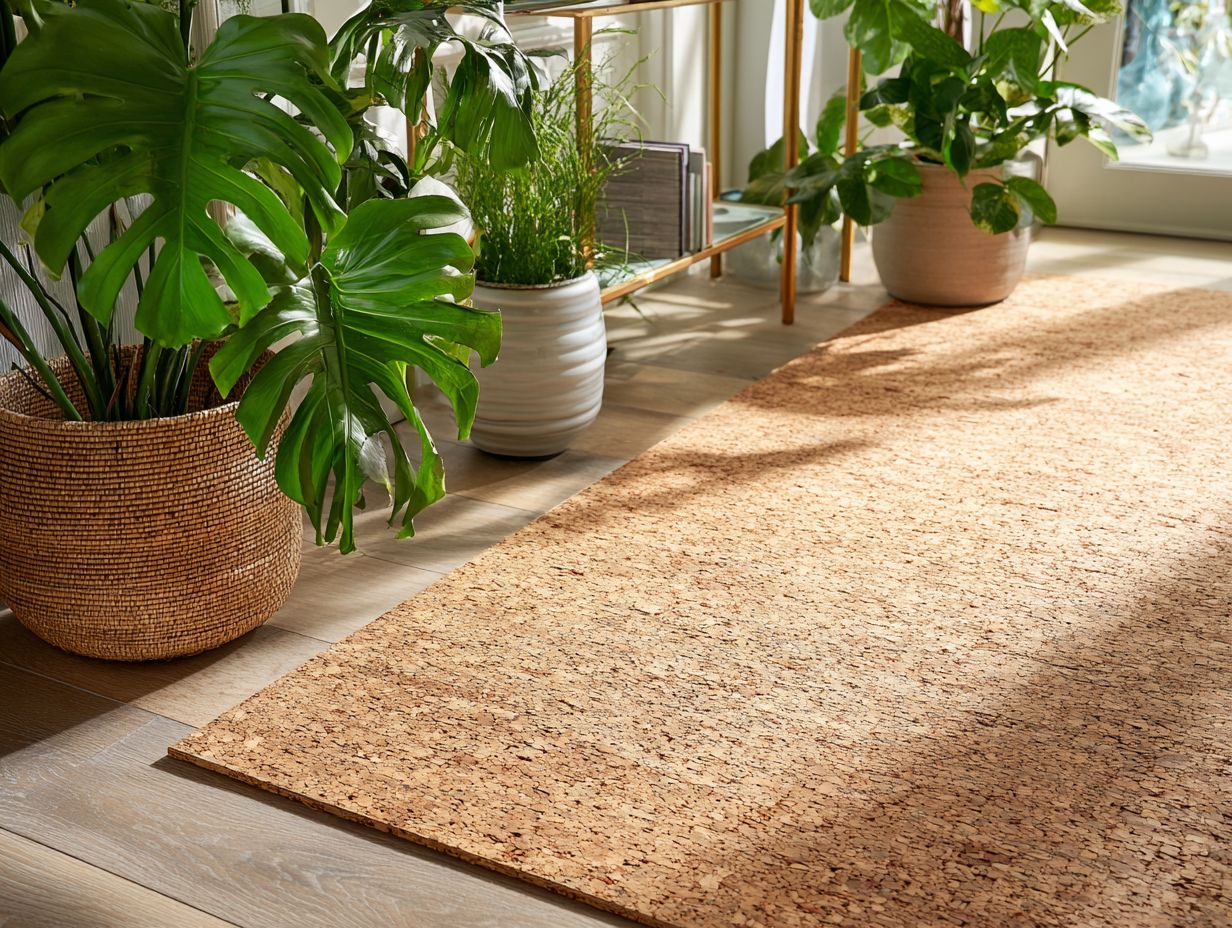
Cork flooring is popular because it is comfortable, eco-friendly, and has unique features, making it a good option for those who want green flooring.
What is Cork Flooring?
Cork flooring is a natural product made from the bark of cork oak trees, known for its durability and resistance to moisture.
Its composition primarily includes cork granules bound with natural adhesives, creating a lightweight yet sturdy material.
The production process involves harvesting the bark without harming the tree, ensuring sustainability.
Cork’s unique properties make it comfortable underfoot, which is especially beneficial in residential spaces and offices.
Its sealed structure provides excellent insulation and reduces noise, making it ideal for gyms or libraries.
For maintenance, simply sweep or mop with a gentle cleaner to preserve its appearance and longevity.
History of Cork as a Flooring Material
Cork flooring has been popular since the 1800s, changing from a specialized option to a common choice due to environmental benefits.
Originally harvested from the bark of cork oak trees in Portugal, cork flooring gained prominence for its insulating properties and durability.
In the 20th century, the introduction of modern manufacturing techniques made cork more accessible, leading to increased use in homes and commercial spaces.
Environmental awareness surged in the 21st century, and cork’s renewable nature, coupled with its low VOC emissions, positioned it as a top choice for eco-conscious consumers.
Recently, waterproof coatings have made cork more popular for kitchens and bathrooms.
Sustainability of Cork Flooring
Cork flooring is well-known in the flooring market because it is gathered in an environmentally friendly way and comes from a resource that can be replenished.
Cork Flooring Sustainability Data
Cork Flooring Sustainability Data
Environmental Impact and Features: Renewability
Environmental Impact and Features: Design and Material Properties
The Cork Flooring Sustainability Data outlines the ecological benefits and unique material properties of cork flooring, highlighting its potential as a sustainable choice for modern building projects.
Environmental Impact and Features emphasize cork’s exceptional renewability: it is a 100% renewable resource, meaning it can be harvested without harming the tree, allowing for continuous regrowth. Cork oak trees greatly improve environmental health by taking in up to 500% more CO2 compared to normal trees, contributing to carbon sequestration and climate change mitigation.
- Design and Material Properties: The unique structure of cork includes about 200 million air cells per cubic inch, comprising 50% of its total volume. The tiny air pockets in cork make it a good insulator, which is why it is a popular option for floors in homes that want to reduce energy use. The air cell structure offers thermal insulation and absorbs sound, improving comfort and acoustics in homes and businesses.
The data shows cork is a sustainable flooring choice, providing environmental advantages and excellent performance. Its renewability and carbon absorption capabilities position cork as an environmentally-friendly choice, while its material properties offer practical advantages in building design. With more people interested in eco-friendly living and buildings that use less energy, cork flooring is an excellent and environmentally-friendly choice.
Renewable Resource
Cork comes from cork oak trees. These trees regrow their bark every 9-12 years, making cork a resource that can be replenished.
This harvesting process benefits businesses and greatly helps environmental protection.
Cork forests, mainly located in the Mediterranean area, are important for preserving biodiversity because they offer living spaces for different species, including those at risk of extinction. These forests absorb carbon dioxide, helping mitigate climate change.
Eco-friendly approaches let us harvest and reuse each tree multiple times throughout its lifespan. This helps protect the environment and provides financial support to nearby communities. Through responsible cork harvesting, we contribute to a healthier planet and promote ecological balance.
Environmental Impact of Cork Harvesting
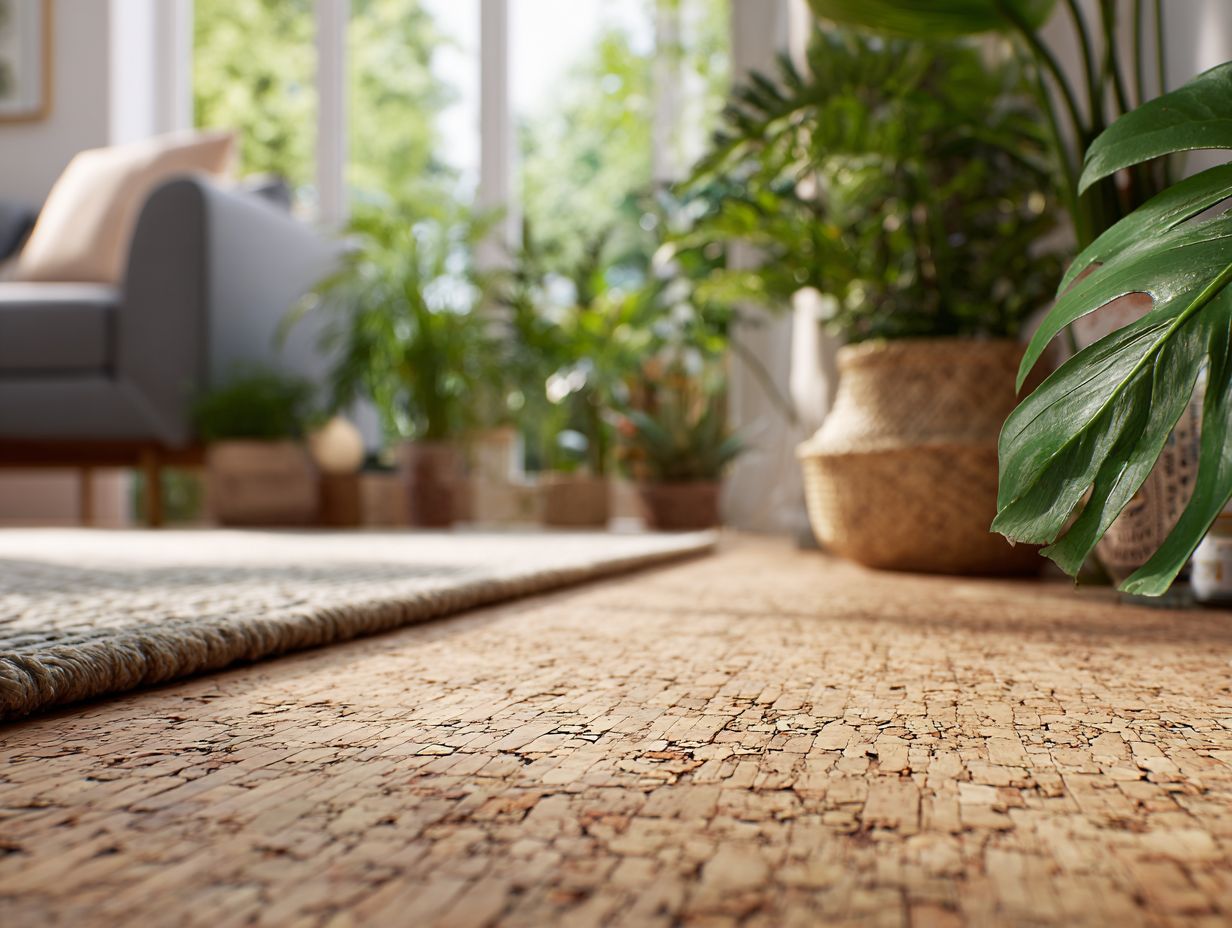
The environmental impact of cork harvesting is largely positive, supporting local ecosystems and preventing deforestation.
Taking cork bark from trees helps various plants and animals in oak forests because the trees remain unharmed and their bark is gently taken off every 9-12 years. This practice maintains habitats for species like the Iberian lynx and various birds.
The cork oak forests are important for keeping soil in place, stopping erosion, and helping the ground hold water. The production process also encourages landowners to manage their forests sustainably rather than opting for more destructive agricultural practices.
Thus, cork harvesting is a model of ecological balance and conservation.
Biodegradability and Recycling
Cork flooring decomposes naturally and can be recycled, making it a great choice for eco-friendly flooring.
Once discarded, cork flooring can be repurposed in various innovative ways. For example, it can be turned into coasters or wall art, giving a unique touch to home dcor.
Cork granules can be used in sustainable gardening practices to improve aeration in potting mixes.
Companies like Amorim and Granorte offer collection programs for used cork, ensuring it is processed into new products. This system reduces waste and highlights cork as a practical, environmentally friendly material, making it an appealing option for consumers interested in sustainability.
Comfort Benefits of Cork Flooring
Cork flooring offers great comfort benefits, such as keeping warmth in, reducing noise, and feeling soft to walk on. For a deep dive into similar flooring options, including their construction and benefits, our comprehensive study on laminate flooring provides additional insights.
Thermal Insulation Properties
Cork acts as a natural insulator, keeping homes warmer in winter and cooler in summer, leading to reduced energy costs.
Research indicates that cork can reduce energy loss by up to 30% compared to traditional flooring materials.
For instance, a study found that homes with cork flooring maintained a more stable temperature than those with hardwood or laminate, which can lead to significant savings on heating and cooling bills.
Cork’s cellular structure traps air, enhancing its insulation properties. It actually provides about 20% better thermal resistance than hardwood, which makes it a great option for energy-efficient homes.
Sound Absorption Qualities
Cork flooring is designed to absorb sound, making it ideal for homes that need to reduce noise.
This flooring type can achieve noise reduction ratings of up to 53%, significantly outperforming hardwood or tile. In comparison, hardwood typically offers a noise reduction of around 20-30%, and tile may provide even less, often leading to echoes in open spaces.
Cork is particularly effective in environments like apartments, where sound travel is a concern, and can be used in home theaters or playrooms to create a quieter atmosphere. Its capacity to compress when stepped on creates a comfortable and noise-reducing surface, improving overall living quality.
Softness and Cushioning
The natural cushioning of cork flooring makes it a comfortable option for walking and standing, reducing fatigue over long periods.
Studies reveal that cork flooring can decrease foot fatigue by up to 40% compared to traditional hardwood or tile options. Users often report feeling less discomfort after standing for hours on cork.
For instance, a testimonial from a restaurant owner highlights how switching to cork flooring resulted in happier staff and improved productivity.
Cork’s natural properties include shock absorption, which benefits those who are on their feet frequently, like retail workers or healthcare professionals. Using cork alongside ergonomic mats can make standing more comfortable.
Health Benefits
Cork flooring is a good choice for health because it doesn’t cause allergies and doesn’t allow mold or mildew to grow, making it safe for homes (see also: Understanding Laminate Flooring – Construction & Benefits).
Hypoallergenic Properties
Cork flooring is naturally resistant to allergens, such as dust mites and pet dander, promoting a healthier indoor environment.
This hypoallergenic property is due to cork’s unique cellular structure, which is capable of preventing the accumulation of particles that contribute to allergies. Studies show that cork contains natural compounds called suberin, which inhibit the growth of mold and bacteria.
Cork’s ease of cleaning encourages regular maintenance, further reducing allergens. To get the most out of these benefits, think about installing cork flooring in bedrooms and living areas. This will create a smooth look and help keep the air clean throughout your home.
Resistance to Mold and Mildew
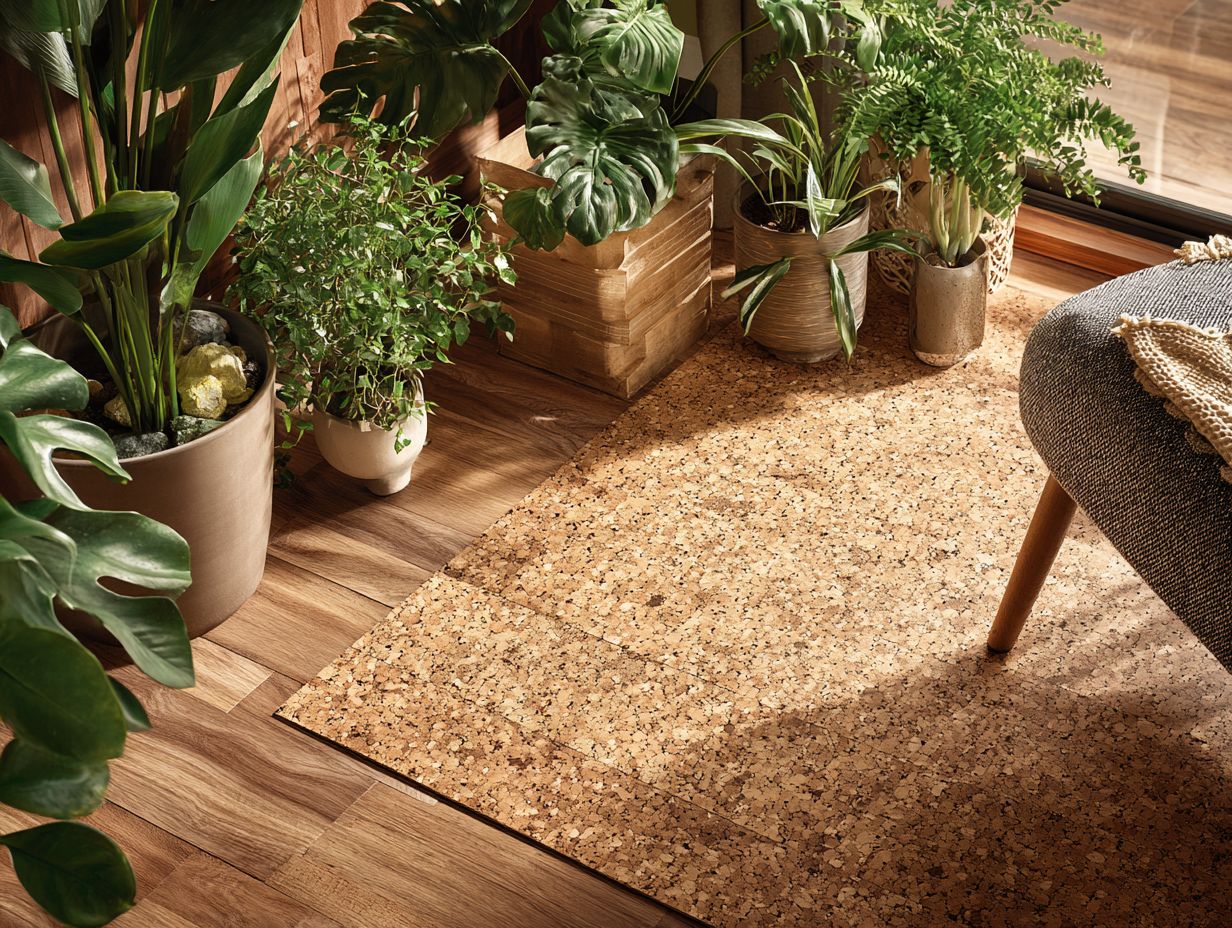
Cork’s natural composition makes it resistant to mold and mildew, reducing the risk of indoor air quality issues.
This resistance stems from cork’s cellular structure, which contains suberin, a waxy substance that helps repel moisture. Studies have shown that cork flooring can significantly limit mold growth, especially in high-humidity environments like basements.
For instance, a user reported that after installing cork in their bathroom, they noticed less moisture-related issues compared to previous flooring. Using a pH-neutral cleaner regularly helps keep surfaces looking good and working well for a long time, while also contributing to a healthier indoor space.
Installation and Maintenance
Proper installation and maintenance of cork flooring can extend its lifespan and improve its performance, making it a practical flooring choice.
Installation Process
Putting in cork flooring includes a few important tasks: getting the surface ready, allowing the planks to adjust to the room, and applying the correct glue.
- Begin by ensuring the subfloor is clean, dry, and level, which may take around 2 hours.
- For acclimation, leave the cork planks in the room for at least 48 hours to adjust to the temperature and humidity.
- For adhesive, pick a high-quality urethane-based glue for a firm bond. Apply the adhesive in a zigzag pattern with a notched trowel, allowing about 3-4 hours for drying before walking on the floor.
Common mistakes to avoid include using wet materials or neglecting to check for moisture levels in the subfloor.
Cleaning and Maintenance Tips
Routine maintenance of cork flooring can extend its lifespan, with specific cleaning techniques recommended for optimal care.
To maintain your cork flooring’s appearance, stay away from strong chemicals that can remove its finish; use a mild pH-neutral cleaner instead. Clean the floor regularly with a wet mop, but don’t let the floor get too wet.
Apply a cork sealant every few years to protect it from moisture and damage. Create a maintenance schedule:
- Weekly damp mopping
- Monthly deep cleaning
- Sealant application every 3-5 years
This active method can greatly improve how long your cork flooring lasts and how it looks.
Cost Considerations
It’s important for homeowners to know about the costs of cork flooring, including what it costs to start and how much money it might save over time. For those comparing options, understanding the composition, cost, and durability differences between flooring types can be beneficial, as highlighted in our expert opinion on Porcelain vs Ceramic Tile.
Initial Investment vs. Long-term Savings
While cork flooring may have a higher initial investment (average $3-$6 per square foot), it can lead to significant long-term savings in energy costs.
Cork is a natural insulator, helping maintain a stable indoor temperature and reducing heating and cooling expenses. Over a 10-year period, energy savings can amount to approximately $1,000, depending on your local climate and energy rates.
Cork flooring is highly durable, boasting a lifespan of up to 30 years with proper maintenance, far surpassing traditional hardwood or vinyl options. When you factor in these long-term savings and durability, cork flooring becomes an economically viable choice.
Comparative Cost Analysis with Other Flooring Options
A comparative analysis shows cork flooring priced between hardwood ($5-$15/sq ft) and laminate ($1-$5/sq ft), balancing affordability with quality.
When considering durability, cork typically lasts 10-30 years, depending on maintenance, while hardwood can endure 20-100 years with proper care. Laminate typically lasts between 15 to 25 years.
Maintenance costs vary: cork floors require resealing every few years, costing $0.50-$1 per square foot. Hardwood floors need refinishing every 5-10 years, costing $3-$5 per square foot. Laminate is easy to care for, only needing occasional mopping and no refinishing.
In family-friendly environments, cork stands out for its sound absorption, while hardwood adds elegance. Choose based on your lifestyle and budget.
Summary of Benefits
Cork flooring provides benefits such as durability, comfort, sustainability, and health advantages, highlighting its versatility as a flooring material.
One main benefit of cork flooring is its eco-friendly nature; it is made from the bark of cork oak trees, which is harvested without harming the trees, making it an environmentally responsible option.
Cork acts as a natural insulator, providing comfort underfoot and reducing energy costs by maintaining room temperature.
Health-wise, cork is hypoallergenic and resistant to mold and mildew, promoting cleaner indoor air quality.
Economically, while the initial investment can be higher, cork flooring often proves cost-effective over time due to its long lifespan and low maintenance needs.
Final Thoughts on Choosing Cork Flooring
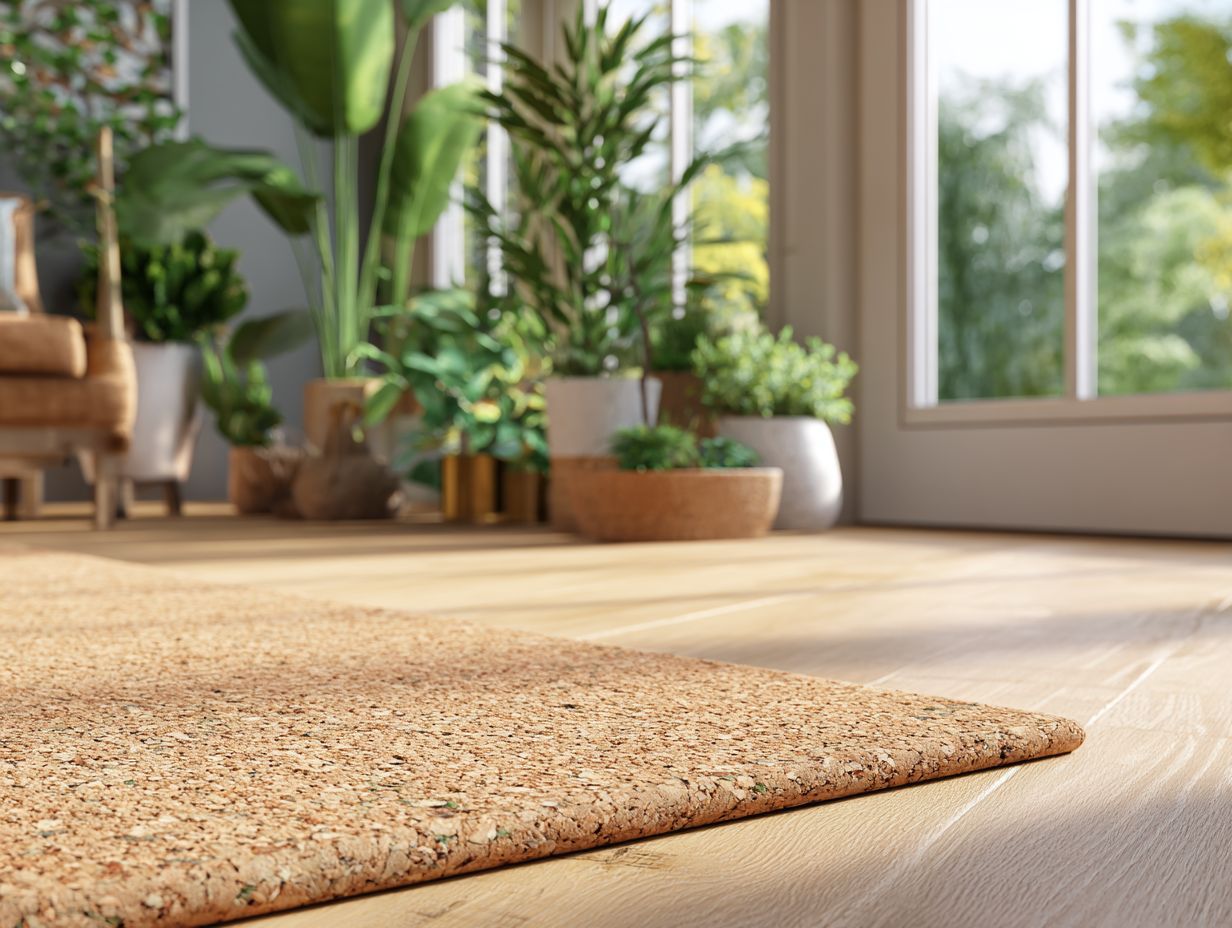
Picking cork flooring is a wise choice for those wanting both comfort and an eco-friendly option.
To make the most of this choice, consider looking for high-quality, eco-certified products. Brands like Jelinek Cork offer a range of flooring options made from sustainable materials, promoting both durability and environmental responsibility.
Different ways to install flooring are available. Choosing a glue-down method can make floors more stable in busy areas, while floating floors are simpler to install and need less preparation.
Maintain your cork flooring using natural cleaners, ensuring longevity and preserving its unique aesthetic appeal.
Additional Resources
If you want to learn about cork flooring, there are many resources to help you choose and buy it.
Where to Buy Cork Flooring
Cork flooring can be purchased from various retailers, including Wicanders and Amorim, both known for their quality and eco-friendly certifications.
You can also find reliable options at Home Depot and Lowe’s, which offer a variety of styles and price ranges.
When selecting cork flooring, look for products with a high-density core for durability and a 7 mm thickness or more for better sound insulation.
Asking for samples before buying is very important; a lot of retailers offer them for free or for a small fee.
Consulting with flooring experts can help you choose the best product for your specific needs, ensuring that your investment is sound.
Frequently Asked Questions
What makes cork flooring a sustainable choice?
Cork flooring is considered to be one of the most sustainable flooring options available due to the use of renewable and natural materials. Cork comes from the bark of cork oak trees. This bark can be collected every 9-12 years without damaging the tree. This means that cork flooring is a renewable resource and has a much lower impact on the environment compared to other flooring materials.
Does cork flooring have any health benefits?
Yes, cork flooring is known for its many health benefits. It naturally fights off mold, mildew, and bacteria, making it a good choice for people with allergies or breathing problems. It also has a soft and cushioned surface, providing a comfortable and shock-absorbing feel underfoot, which can be beneficial for those with joint or back pain.
Can cork flooring be used in high-traffic areas?
Despite its soft and cushioned surface, cork flooring is surprisingly durable and can withstand high foot traffic. Its natural flexibility lets it recover from dents and scratches, making it a suitable choice for high-traffic places like kitchens, hallways, and children’s playrooms.
Is cork flooring water-resistant?
While cork flooring is not completely waterproof, it does have natural water-resistant properties due to the presence of suberin, a waxy substance found in cork cells. This makes it a suitable flooring option for areas that may experience moisture, such as bathrooms or basements. Make sure to clean up spills and extra water to avoid harm.
Is cork flooring easy to maintain?
Yes, cork flooring is one of the easiest types of flooring to maintain. It is naturally resistant to dirt and stains, and can be easily cleaned with a damp mop and a mild cleaning solution. It is also scratch-resistant, but in the event of any scratches or dents, they can be easily repaired by sanding and refinishing the flooring.
Are there any style options for cork flooring?
Absolutely! Cork flooring is available in different colors, patterns, and textures, making it a stylish and flexible choice for any home. It can be left natural for a more organic look, or stained and finished for a more modern and contemporary feel. With its unique appearance and sustainability benefits, cork flooring is a great choice for any design style.
